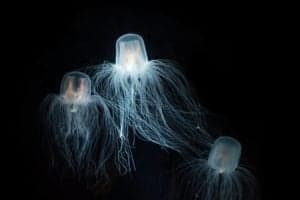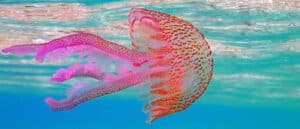Jellyfish are free-swimming marine species with long tentacles. There are more than 200 species of “true jellyfish” in the world. While most of them cause only slight pain and discomfort, some are highly venomous. Their stinging cells produce toxins that are pretty dangerous to humans. A certain type gives the worst jellyfish sting.
According to a study by Marine Drugs, 150,000 jellyfish stings happen every year, with some areas reporting up to 800 cases daily. Jellyfish are continuously becoming a threat to tourists in the Pacific regions.
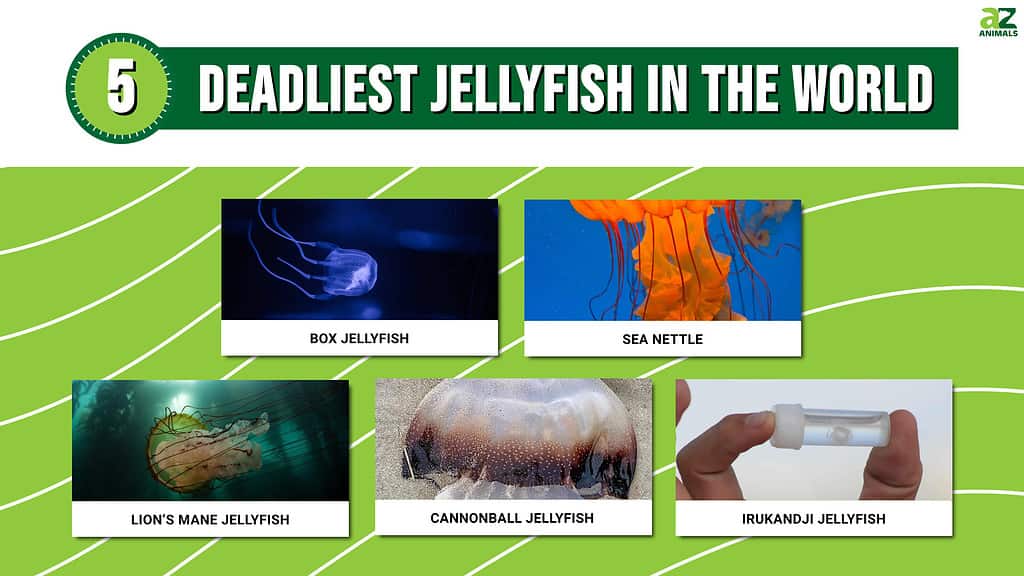
Based on the Journal of Travel Medicine, 20 to 40 people die annually due to jellyfish stings in the Philippines. Many jellyfish stings still occur throughout the year, despite the constant awareness published in various journals regarding the potential dangers of jellyfish.
Jellyfish stings are becoming more common worldwide than we already know. Therefore, it’s important that we get to know the deadliest jellyfish, their appearance, and where they are found so that we can avoid coming into direct contact with them.
Here is one of the world’s deadliest jellyfish and everything you need to know about it. It gives the worst jellyfish sting.
The deadliest jellyfish in the world: The box jellyfish
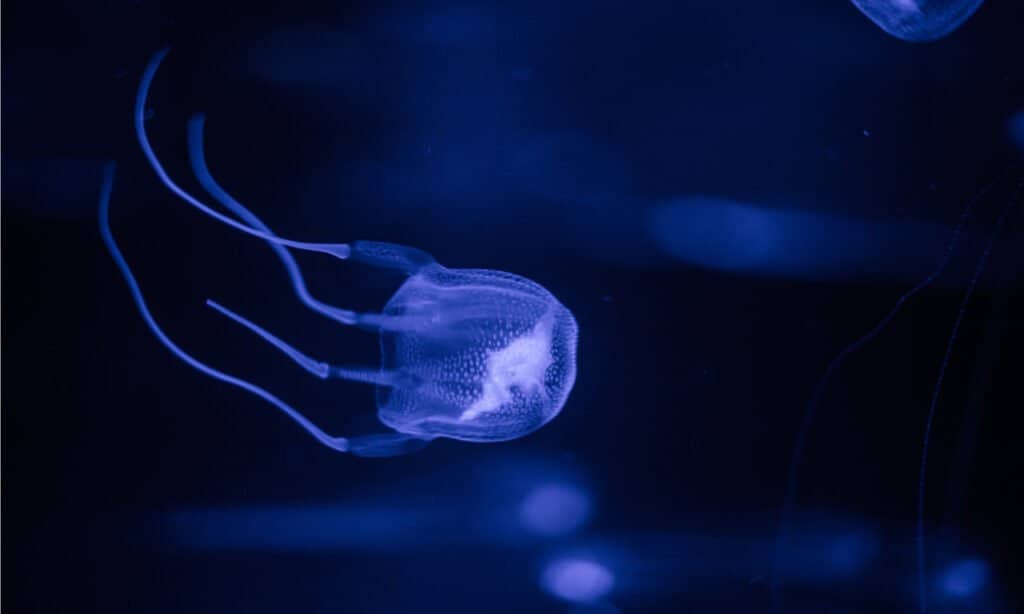
The venom of a
box jellyfish
is extremely painful.
©Dewald Kirsten/Shutterstock.com
The Australian box jellyfish (Cubozoa) is the world’s deadliest jellyfish and marine animal in the world. They are native to Australia and surrounding waters. There are about 30 to 50 species of box jellyfish in the Indo-Pacific and the coastal waters of Australia. All these species produce a deadly venom that is extremely painful.
The box jellyfish is named for their body shape. They have tentacles covered in booby traps known as nematocysts. They are basically tiny darts that are loaded with poison. People and animals alike are unfortunate enough to be injected with this poison may experience paralysis, heart failure, and even death and that’s all just minutes after being stung.
The box jellyfish sting is enough to cause you a shock or even a heart attack. Many people end up drowning because of the sharp pain caused by box jellyfish bites. Survivors may continue to feel the pain several weeks later.
It is possible to encounter a box jellyfish while swimming. Snorkelers and scuba divers are usually more cautious about the box jellyfish because they know how deadly they are, even though they don’t seem dangerous judging from their appearances.
Therefore, knowing that the box jellyfish are out there should be a perfect reminder of how you should always wear protective clothing while scuba diving or snorkeling.
What is the appearance of the box jellyfish?

There are more than 50 species are box jellyfish so their appearance can differ. However, most feature long tentacles.
©Danza/Shutterstock.com
The box jellyfish that causes the most danger to humans is Chironex Fleckeri. It goes by other nicknames including the Australian box jellyfish and the sea waslp.
The box jellyfish is pale blue in color and transparent, making them almost invisible. They have a cube-like bell that’s around 35 cm in diameter. That’s how they got their name, “box jellyfish.” They have about 15 tentacles that are attached to their pedalium. They have four pedalia, meaning all the tentacles are around sixty. Every tentacle holds up to 5,000 stinging cells.
The box jellyfish also have an advanced cluster of eyes to facilitate their sight. There is a retina, iris, lens, and a complicated cornea in their eyes. However, they don’t have a central nervous system. So, scientists are still trying to understand how they process everything they see around them.
Most species of jellyfish don’t swim but drift to wherever currents take them. This doesn’t apply to box jellyfish because they have a unique ability to propel their bodies through the water rather than just floating. They can swim at a speed of up to four knots.
How big is the box jellyfish?
The box jellyfish is about 20 cm (8 inches) in size. It has a diameter of around 30 cm (12 inches). Their tentacles are approximately 10 feet in length. The box jellyfish weighs about 2 kg (4.5 pounds) on an average. Their weight may vary depending on the surroundings and the age of the box jellyfish.
Where do box jellyfish live?
All species of box jellyfish live in different types of habitats. They all have different preferences. Nevertheless, most box jellyfish species live in saline and warm waters near the shores where the water is shallow. The Australian box jellyfish is found most often off the Cape York Peninsula and northern beaches of the country. They’re also found across Indonesia, the Philippines, and can also be found off Thailand and Malaysia.
What does the box jellyfish eat?

A box jellyfish is a carnivore, its diet consists of manthris shrimps, annelid worms, arrow worms, and tiny fishes.
©Nuttawut Uttamaharad/Shutterstock.com
The diet of box jellyfish consists mainly of crustaceans, prawns, manthris shrimps, annelid worms, arrow worms, and tiny fishes. They are predominantly carnivores. They use their tentacles to catch their prey and inject it with venom that quickly paralyzes it.
How do box jellyfish reproduce?
Box jellyfish undergo both sexual and asexual reproduction. During the sexual reproduction phase, box jellyfish migrate to freshwater and find suitable mates. This often happens in the spring. The male transfers sperm to fertilize the female eggs during this phase, hence giving rise to planulae. A planula is a free-swimming larva form with a flattened and ciliated body.
During the second reproduction phase, the planulae grow into polyps with around nine tentacles. The polyp then undergoes budding during the spring. Each polyp splits into two or more organisms, which gives rise to baby box jellyfish known as ephyra larvae.
How aggressive is the box jellyfish?
The box jellyfish is very aggressive towards other species, but generally not toward humans. They are only aggressive towards humans when they feel threatened by them. The box jellyfish will then sting in self-defense. Their stings are usually unintentional and happen when a person touches a box jellyfish without realizing it because they are transparent and almost impossible to see.
How toxic is box jellyfish’s venom?
Box jellyfish venom is considered very toxic and acts rapidly. Each box jellyfish has enough venom to kill up to 60 people within 2 minutes. The venom contains toxins that damage skin cells, affect the nervous system, and hinder the heart’s normal function. Their stings are also excruciating, to the point that a person may end up drowning due to the shock they receive from the sharp pain.
What happens if you get stung by a box jellyfish?
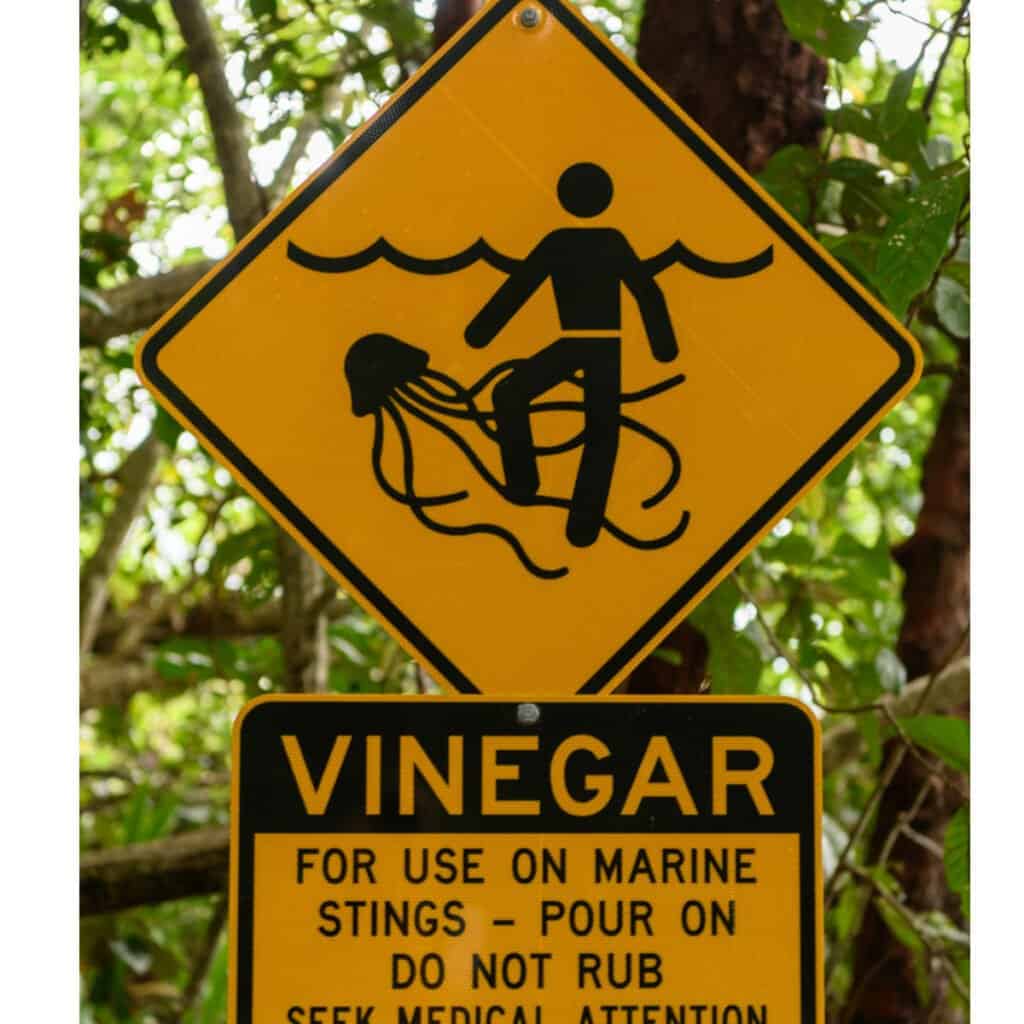
Jellyfish warning signs are common across areas like Australia.
©A Periam Photography/Shutterstock.com
If you accidentally brush against a box jellyfish tentacle, and by chance, it injects its venom into your bloodstream, you will get symptoms within a minute. At first, you will feel a lot of pain that in severe cases can cause heart attacks.
Less severe stings cause symptoms like red, brown, and purplish tracks on your body in addition to the pain you will feel. Survivors can experience discomfort for a few weeks after the sting, and the trails may also start to fade away, though they may leave a lasting scar.
How many people die each year due to a box jellyfish sting?

Box jellyfish produce stingers that are venomous and leave significant effects on the human body.
©DonyaHHI/Shutterstock.com
Approximately 50 to 100 people die each year due to stings from the many species of box jellyfish. However, the number of deaths might exceed the estimate. According to the Philippine Journal of Science, 20 to 40 people die from box jellyfish envenomation each year in the island nation. With box jellyfish having a range that extends across Southeast Asia, there is a chance that box jellyfish deaths around the world are being underestimated.
What Other Jellyfish are Venomous?
The box jellyfish is the world’s deadliest jellyfish, but not the only one. There are other species of jellyfish that are highly venomous as well. Here is an additional list of the five most deadly jellyfish in the world.
1. Sea Nettle

Sea Nettle jellyfish have a venom that is not dangerous to humans.
©Antoine Taveneaux, CC BY-SA 3.0 <https://creativecommons.org/licenses/by-sa/3.0>, via Wikimedia Commons – License
The sea nettle jellyfish are among the venomous jellyfish found on the Atlantic and Gulf coasts. They are yellow to dark brown with long oral arms and tentacles. Their venom is not dangerous to humans. Sea nettle stings only cause pain. However, urgent medical attention is still essential for all victims of sea nettle stings.
2. Lion’s Mane Jellyfish
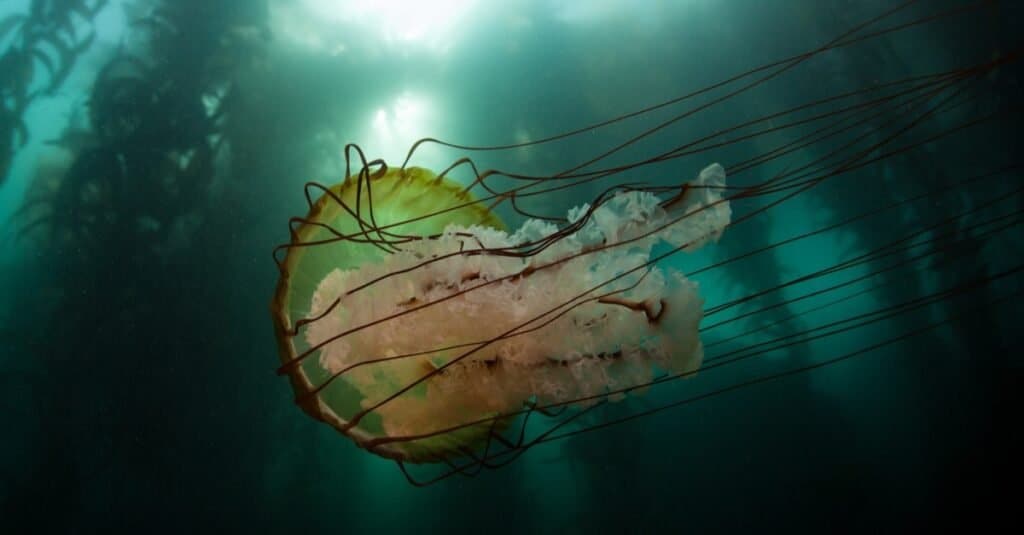
Lion’s mane stings are not totally harmful to humans, but they can cause severe allergic reactions in some people.
©Ethan Daniels/Shutterstock.com
The lion’s mane jellyfish is a highly venomous jellyfish found in the North Pacific and the Arctic Ocean. They prefer calmer water to warmer water. The lion’s mane jellyfish is bright red to purple and has long hair-like tentacles.
Lion’s mane stings are not so dangerous to humans, but they can cause severe allergic reactions in some people. Their stings cause episodes of irritation before subsiding in 1 to 3 weeks.
3. Cannonball Jellyfish
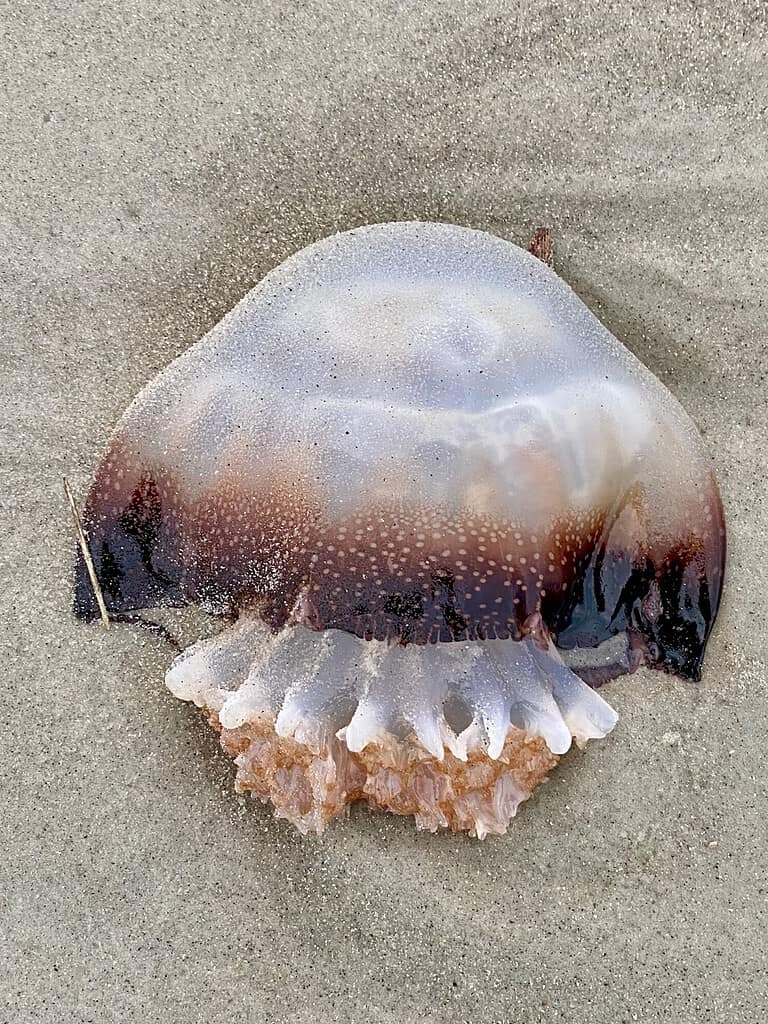
Cannonball Jellyfish can cause heart issues if they sting humans.
©Renee Robbins/Shutterstock.com
Cannonball jellyfish are among the deadliest jellyfish in the world. They can be found in the Midwest, the Atlantic, and the Pacific Oceans. Their color varies from blue to purple. They hardly sting humans unless they are disturbed or threatened.
The cannonball’s venom is very poisonous, and it can cause skin and eye irritations as well as heart problems in people.
4. Irukandji Jellyfish
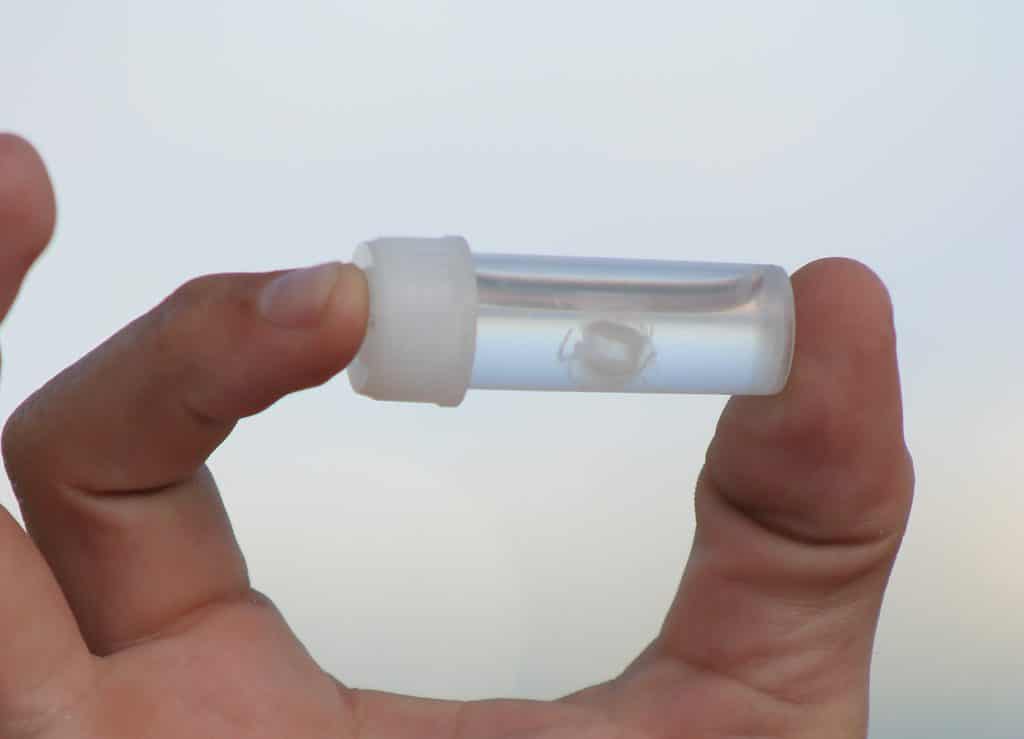
Irukandji jellyfish are so tiny they can barely be seen with the naked eye.
©2,221 × 1,606 pixels, file size: 596 KB, MIME type: image/jpeg – License
The Irukandji jellyfish is an extremely venomous jellyfish species found in Australia’s northern waters. The Irukandji jellyfish produces a highly potent venom that causes severe brain hemorrhages. Their stings are so painful that they even cause cardiac arrest, leading to death.
5. Moon Jellyfish

Moon jellyfish have bodies that are transparent.
©Vladimir Wrangel/Shutterstock.com
The moon jellyfish is the most common venomous jellyfish species found in all the oceans worldwide. They are slightly blue or pinkish. They are also transparent, like box jellyfish.
Moon jellyfish are less harmful to humans because they lack long tentacles to inject venom. However, they have very short tentacles, which they rarely use to sting humans. Basically, they sting when they feel threatened. The moon jellyfish venom mainly affects the skin and blood.
Summary of the Deadliest Jellyfish in the World
| Number | Jellyfish | Tentacle Length |
|---|---|---|
| 1 | Sea Nettle | 25 ft (7.5 m) |
| 2 | Lion’s Mane Jellyfish | 100 ft (30.5 m) |
| 3 | Cannonball Jellyfish | No Tentacles |
| 4 | Irukandji Jellyfish | 50 – 500 mm |
| 5 | Moon Jellyfish | 1 – 5 cm |
Can a dead jellyfish hurt you?
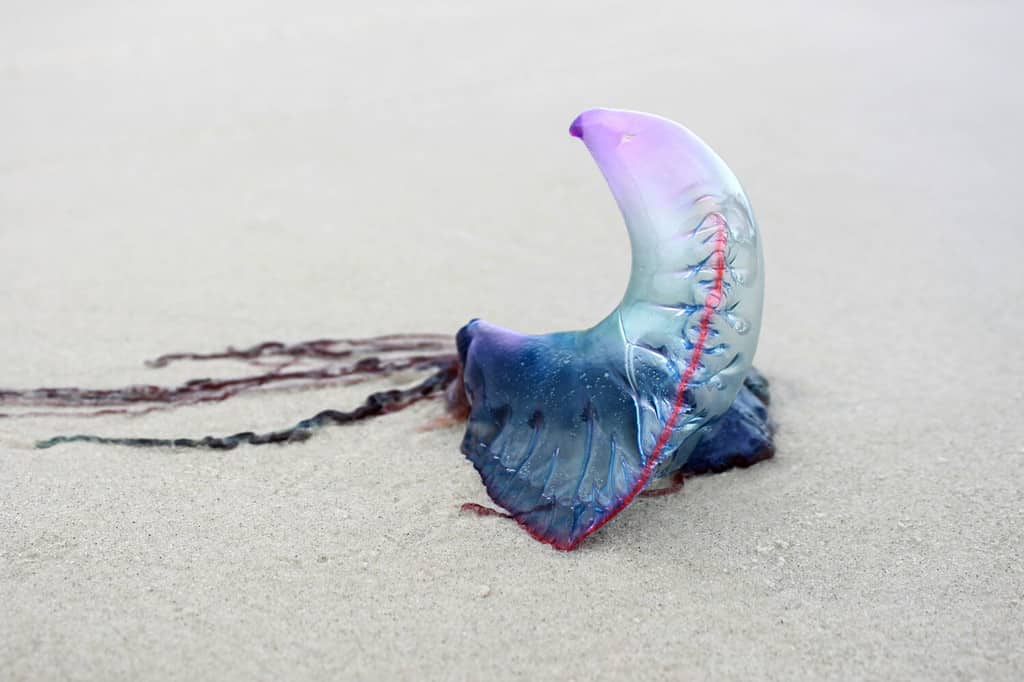
It is best to stay away from dead jellyfish like this Portuguese man-o’-war on the beach sand.
©Pedro Sales Prado/Shutterstock.com
While it might be enticing to get close and examine a jellyfish (especially because they can be very beautiful and colorful) that has been washed up on the shore and found dead, they are still as dangerous as they are when they are alive in the water. It is wise to show caution and avoid the carcass, rather than poking or prodding it.
The reason jellyfish are so dangerous is because their tentacles or other parts of their body contain microscopic barbs that deploy their venom, which is why they are venomous and not poisonous. With those tiny barbs on their skin, a dead jellyfish’s body can still very easily inject its venom when and if it comes in contact with a human, mainly any exposed skin.
The photo featured at the top of this post is © Daleen Loest/Shutterstock.com
Thank you for reading! Have some feedback for us? Contact the AZ Animals editorial team.



